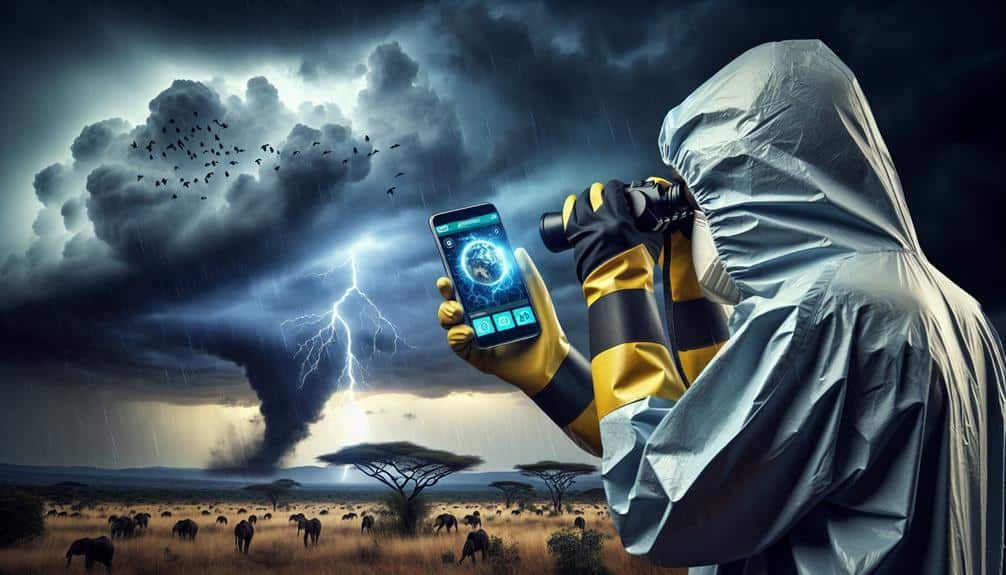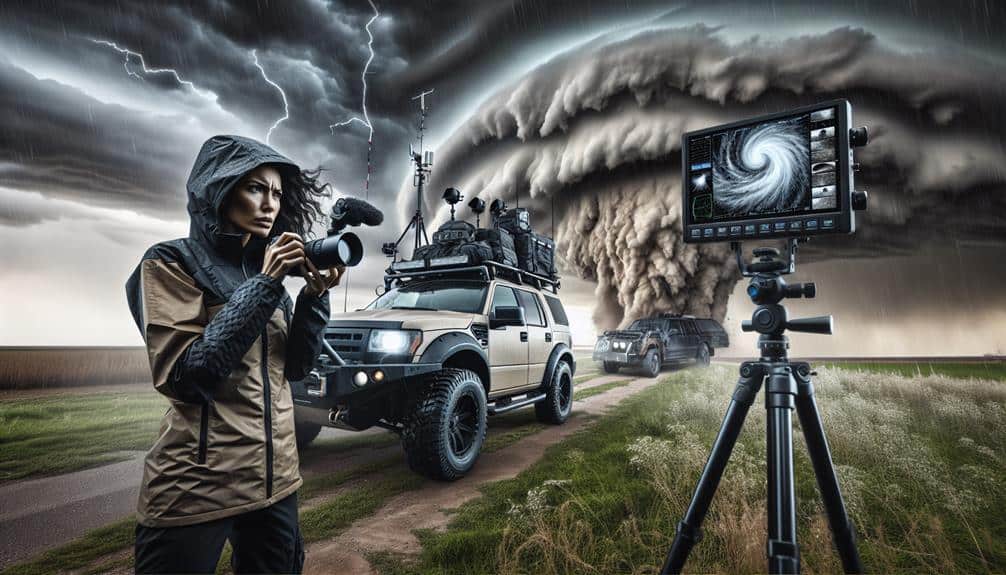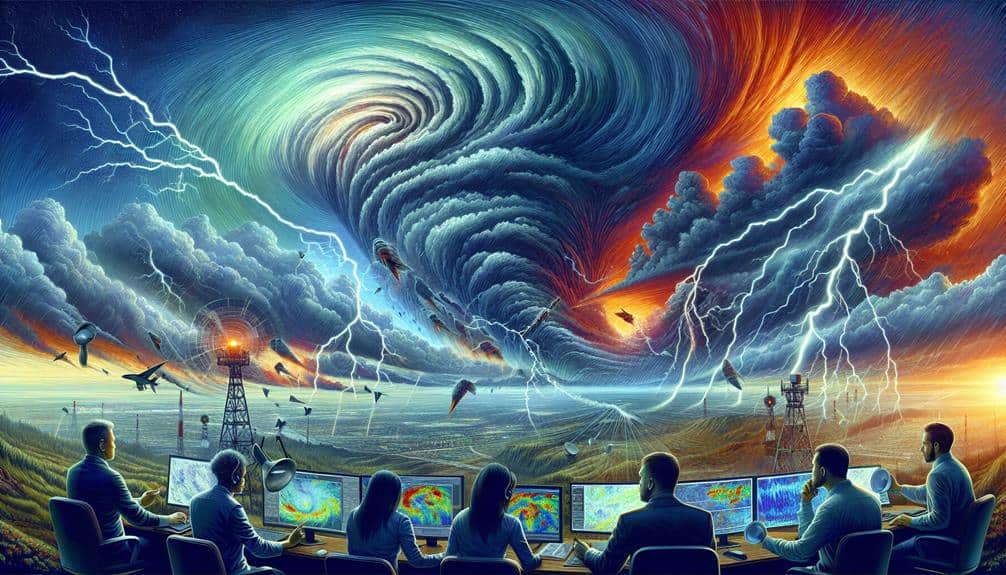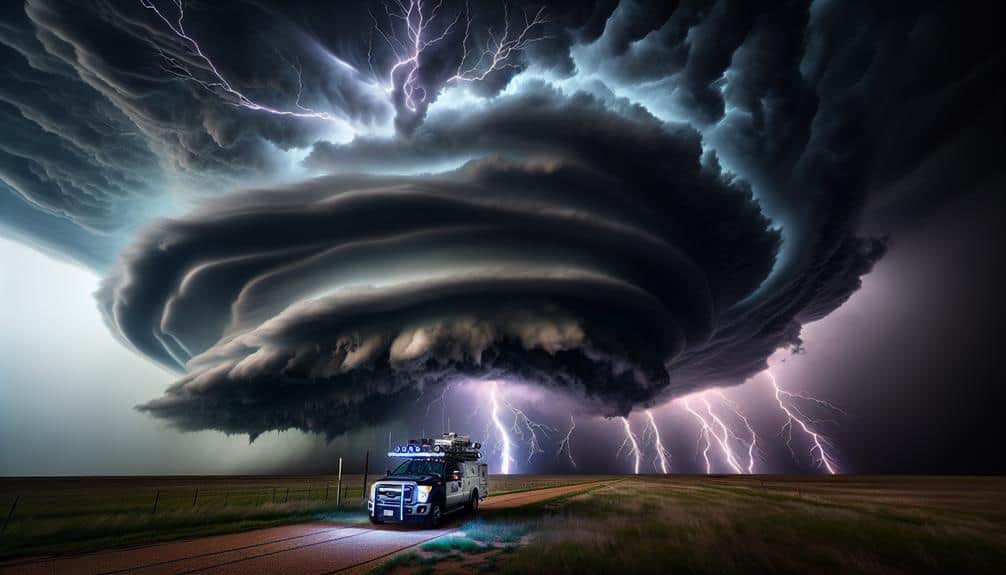We use storm chasing apps because they provide unmatched real-time weather updates and precise storm predictions, leveraging advanced meteorological algorithms and high-resolution radar imagery. Real-time alerts based on geolocation guarantee our safety with hyper-localized notifications. These apps integrate vast datasets and machine learning to predict storm paths accurately, minimizing delays and optimizing preparedness. Customizable alerts tailored to specific parameters help us act promptly. Community sharing enhances data accuracy and situational awareness. By analyzing historical data, these apps enhance our ability to anticipate future weather events. For a thorough understanding of these benefits, explore further details.
Key Points
- Real-time weather updates provide minute-by-minute data and hyper-localized alerts.
- Advanced radar technology offers precise analysis of storm intensity and trajectory.
- Community sharing features enhance situational awareness through crowdsourced data.
- Customizable alerts ensure timely and relevant notifications based on specific storm parameters.
Real-Time Weather Updates
Real-time weather updates provided by storm chasing apps deliver precise, minute-by-minute data that enables us to make informed decisions during severe weather events. With these apps, we receive instantaneous weather alerts, which are essential for initiating timely emergency response protocols. The accuracy and granularity of the data allow us to assess the severity and trajectory of storms in real-time, optimizing our ability to stay ahead of potentially hazardous situations.
By leveraging advanced meteorological algorithms and high-resolution radar imagery, these apps offer unparalleled insight into storm dynamics. We can pinpoint the exact location of a storm cell, monitor its movement, and predict its impact with impressive accuracy. This real-time capability is invaluable for those of us who value our freedom and need to act swiftly during emergencies.
Moreover, the integration of geolocation services within these apps guarantees that weather alerts are hyper-localized. This means we receive notifications specific to our current location, enhancing our capacity for rapid emergency response. Being armed with precise, up-to-date weather information empowers us to safeguard ourselves and our communities effectively.
In a world where weather conditions can change in an instant, having real-time updates is a game-changer.
Accurate Storm Predictions
We can enhance our storm tracking accuracy by leveraging real-time weather updates and advanced predictive models. These apps use high-resolution data and machine learning algorithms to forecast storm paths with remarkable precision.
Real-Time Weather Updates
Leveraging advanced algorithms and meteorological data, these storm chasing apps offer precision-driven predictions that keep users informed about severe weather developments in real-time. By harnessing live updates, we gain timely insights into evolving weather conditions, enabling us to make informed decisions quickly. These updates are essential for those who value freedom and need to stay one step ahead of unpredictable storms.
The apps provide not only continuous monitoring but also emergency notifications that alert us to imminent threats. This real-time functionality guarantees that we can respond promptly and take necessary precautions. When a tornado is forming or a severe thunderstorm is approaching, receiving instant alerts can be a lifesaver. The combination of live updates and emergency notifications creates a robust system for storm tracking.
Moreover, the accuracy of these updates is significantly improved by the integration of multiple data sources, including satellite imagery, radar data, and ground reports. This multi-faceted approach ensures that we receive the most precise and up-to-date information available. By constantly analyzing this data, the apps minimize the delay between a weather event occurring and our receiving the notification, thereby optimizing our preparedness and safety.
Advanced Predictive Models
Building on the foundation of real-time updates, storm chasing apps utilize advanced predictive models to deliver highly accurate storm forecasts. By leveraging machine learning algorithms and vast datasets, we can predict storm paths, intensities, and potential impact zones with remarkable precision. These models analyze historical data, atmospheric conditions, and current weather patterns to generate forecasts that allow us to make informed decisions on the ground.
Data visualization plays an essential role in interpreting these intricate models. Storm chasing apps present predictive data through user-friendly, interactive maps and graphs, enabling us to grasp forecast accuracy at a glance. We can quickly identify high-risk areas, track storm development, and adjust our chase strategies accordingly. This level of detail empowers us to act decisively, maximizing both our safety and the effectiveness of our storm chasing efforts.
Additionally, these advanced predictive models continuously update as new data comes in, ensuring that our information remains current and reliable. The fusion of real-time updates with sophisticated forecasting tools provides a thorough situational awareness that's unmatched.
Enhanced Safety Measures

Incorporating real-time data analytics, storm chasing apps greatly enhance safety measures by providing accurate and timely alerts about severe weather conditions. These apps leverage high-resolution radar data, satellite imagery, and predictive models to inform us of impending storms. This level of detail empowers us to make informed decisions, bolstering our emergency response capabilities. When seconds are critical, having access to immediate, precise information is essential for safeguarding lives and property.
We can't emphasize enough the importance of disaster preparedness. Storm chasing apps offer features like automated notifications and geofencing, which alert us based on our current location. This targeted approach ensures that we receive relevant information without unnecessary clutter, allowing for swift action. Additionally, the integration of historical data trends helps us understand the likelihood and patterns of severe weather, aiding in long-term planning and risk assessment.
Community Sharing Features
Let's examine the community sharing features of storm chasing apps.
We will focus on real-time data sharing, collaborative mapping tools, and user-generated alerts. By leveraging these functionalities, we can enhance data accuracy and improve situational awareness.
User contributions facilitate rapid information dissemination, essential for timely response and decision-making.
Real-time Data Sharing
One of the most powerful features of storm chasing apps is live data sharing, which allows users to instantly distribute and receive updates from a community of fellow storm chasers. This capability greatly improves data accuracy and situational awareness.
With live data sharing, we can receive instant notifications about storm developments, which is essential for making timely decisions.
These apps utilize a network of users to gather and share data on various storm parameters. By combining data from multiple observers, we can validate and cross-check information, leading to higher data accuracy. This collaborative approach ensures that we're not solely dependent on automated systems or singular data points.
Furthermore, immediate notifications keep us informed about sudden changes in storm behavior. Whether it's a shift in wind direction or the formation of a funnel cloud, prompt alerts enable us to act swiftly. This is particularly important for those of us who value the freedom to explore and chase storms while prioritizing safety.
In essence, live data sharing democratizes storm tracking, empowering us with accurate, timely information that improves both our experience and safety in the field.
Collaborative Mapping Tools
How do collaborative mapping tools enhance our ability to track storm paths and share critical information in real-time?
By leveraging data visualization and interactive mapping, we're able to gain a more detailed understanding of storm dynamics. These tools empower us to visualize vast amounts of meteorological data in user-friendly formats, enabling quicker and more accurate decision-making.
Collaborative mapping tools allow us to:
- Aggregate diverse data sources: By combining satellite imagery, radar data, and user inputs, these tools provide a comprehensive view of storm patterns.
- Facilitate real-time updates: As we track storms, we can instantly share our observations and adjustments, ensuring everyone in the community has the latest information.
These features are invaluable for storm chasers who require both flexibility and precision.
The power of collaborative mapping lies in its ability to unite our efforts, making storm tracking not just an individual task but a community-driven initiative. This collective intelligence, harnessed through advanced data visualization and interactive mapping, augments our ability to respond proactively and protect our communities.
User-Generated Alerts
Building on the collaborative power of mapping tools, user-generated alerts further enhance our storm tracking capabilities by enabling real-time, community-driven reporting of storm conditions and hazards. By leveraging crowdsourced information, we gain access to hyper-local data points that traditional meteorological methods might overlook. This real-time, granular data can be a game-changer during severe weather events, providing us with the most current and relevant information.
The inclusion of user-generated alerts in storm chasing apps transforms passive users into active participants, creating a dynamic network of storm watchers. This collective vigilance guarantees that emergency notifications aren't only timely but also accurate, reducing the lag between storm development and public awareness. When multiple users report similar conditions, the reliability of the data increases, allowing for more precise and actionable insights.
Moreover, the analytical benefits of crowdsourced information are substantial. By comparing user reports with radar and satellite data, we can identify patterns and improve predictive models. This integration of community sharing features with advanced meteorological tools empowers us to make better-informed decisions, enhancing both our safety and our freedom to navigate through storm-prone areas effectively.
Advanced Radar Technology

Advanced radar technology revolutionizes our ability to analyze and predict storm patterns with unprecedented accuracy. We no longer rely solely on traditional forecasting methods; instead, we harness cutting-edge radar systems that provide real-time data and sophisticated radar interpretation tools. These advancements empower us to track weather phenomena with a level of precision that was previously unachievable.
Through enhanced radar interpretation, we gain insight into the storm's intensity, trajectory, and potential impact zones. This granular data is essential for making informed decisions during severe weather events. By integrating these radar technologies into storm chasing apps, we enhance our weather tracking capabilities significantly.
Key features of advanced radar technology include:
- Dual-polarization radar: This technology differentiates between types of precipitation (rain, hail, snow), providing a more detailed picture of storm systems.
- Doppler radar: Measures the velocity of precipitation particles, enabling us to detect wind patterns and potential tornado formations.
Using these technologies, we can achieve a higher degree of situational awareness and operational flexibility, which aligns perfectly with our desire for freedom and preparedness in the face of nature's most formidable challenges.
Customizable Alerts
Customizable alerts allow us to receive precise, real-time notifications tailored to specific storm parameters, guaranteeing timely and relevant updates. By leveraging advanced algorithms and data analytics, these apps enable us to set personalized notifications according to our needs. For instance, we can choose to be alerted only for severe weather conditions like tornadoes, hailstorms, or flash floods, minimizing unnecessary interruptions.
Moreover, location-based alerts provide a higher degree of specificity. By using GPS data, these apps send alerts that are pertinent to our exact location, rather than broad regional warnings. This ensures that we receive updates that are directly relevant to our immediate surroundings, enhancing our ability to make informed decisions quickly.
The data-driven nature of these customizable alerts guarantees that we're not inundated with irrelevant information. Instead, we receive actionable insights, helping us to stay ahead of potential threats. For those of us who value our autonomy and the ability to act swiftly in the face of changing conditions, the precision and relevance of these alerts are invaluable.
Historical Data Access

Leveraging historical data access, we can analyze past storm patterns to better predict future weather events and refine our alert settings. Historical data is indispensable for understanding the complexities of storm behavior, and storm chasing apps offer a robust platform for this analysis.
By examining archived data, we gain insights into recurring storm patterns and anomalies, enabling us to make more informed decisions.
Data visualization tools within these apps transform raw data into comprehensible visual formats, such as heat maps and trend lines. This allows us to quickly identify patterns and correlations that might be missed in textual data alone.
Here's how historical data access enhances our storm-tracking capabilities:
- Pattern Recognition: Identifying recurring storm behaviors enables more accurate forecasting.
- Risk Assessment: Analyzing past events helps us evaluate the potential impact of future storms.
Incorporating historical storm data into our tracking processes not only enhances predictive accuracy but also offers the freedom to tailor our responses based on empirical evidence. This data-driven approach empowers us to navigate storm seasons with greater confidence and precision.
Frequently Asked Questions
How Do Storm Chasing Apps Integrate With Other Weather-Related Tools or Systems?
Storm chasing apps integrate with weather forecasting tools through data integration, enhancing emergency response and geographic mapping. We can access real-time data, enabling precise, timely decisions. This synergy optimizes freedom in maneuvering and responding to storms.
What Are the Top-Rated Storm Chasing Apps Available for Different Mobile Platforms?
We're looking at the top-rated storm chasing apps like RadarScope, Storm Shield, and MyRadar. These apps excel in app features, user interface, data accuracy, and real-time updates, providing reliable tools for storm tracking across platforms.
Can Storm Chasing Apps Be Used for Educational Purposes in Schools or Universities?
We can leverage storm chasing apps for educational benefits in classrooms by providing real-time learning opportunities. These apps boost student engagement by integrating data-driven analysis and hands-on activities, making complex meteorological concepts more accessible and engaging.
How Do Storm Chasing Apps Handle Data Privacy and User Information?
We prioritize privacy protection and user security by implementing advanced encryption protocols and anonymizing data. Our storm chasing apps guarantee that user information remains confidential, giving users the freedom to track storms without compromising their personal data.
Are There Costs or Subscription Fees Associated With Using Premium Features in Storm Chasing Apps?
Yes, premium features in storm chasing apps often come with subscription models. While free options exist, alternative costs can include limited functionality. Analyzing user data reveals that subscribing enhances tracking accuracy and access to real-time updates.


